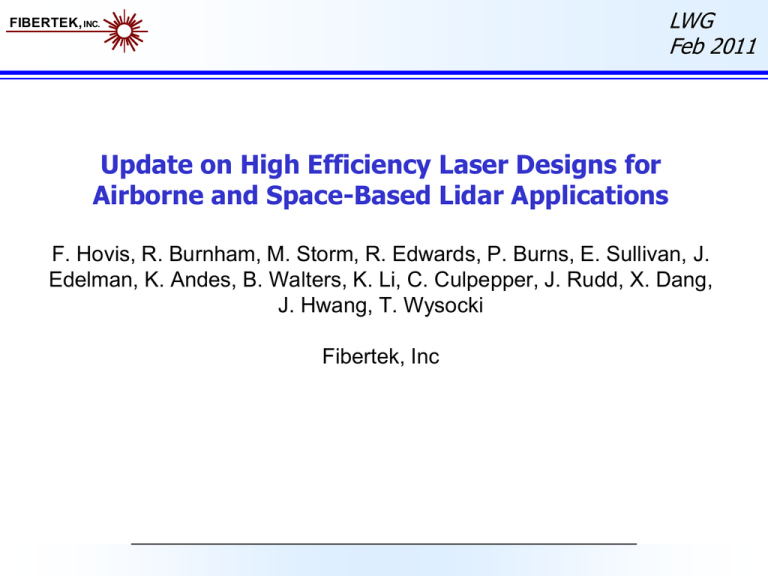HSRL mass estimate based on CALIPSO
advertisement

LWG Feb 2011 FIBERTEK, INC. Update on High Efficiency Laser Designs for Airborne and Space-Based Lidar Applications F. Hovis, R. Burnham, M. Storm, R. Edwards, P. Burns, E. Sullivan, J. Edelman, K. Andes, B. Walters, K. Li, C. Culpepper, J. Rudd, X. Dang, J. Hwang, T. Wysocki Fibertek, Inc FIBERTEK, INC. Presentation Overview LWG Feb 2011 Approaches to high efficiency lasers ICESat-2 prototype laser design overview – Bulk Nd solid-state High-efficiency, single-frequency ring laser development – NASA Phase 1 SBIR – Laser Vegetation Imaging System – Global Hawk (LVISGH) transmitter Future design updates FIBERTEK, INC. LWG Feb 2011 ICESat-2 Laser Requirements Original Laser Support Engineering Services (LSES) contract was to support rebuild of original ICESat laser for ICESat-2 – 1064 nm – 50 mJ/pulse – 50 Hz After LSES award the ICESat-2 design transitioned to micro-pulse lidar approach updates Parameter ATLAS Laser Transmitter Wavelength 532 ± 1 nm Pulse Energy 0.9 mJ, adjustable from 250-900 µJ Pulse Energy Stability 10% RMS over 1 s Pulsewidth < 1.5 ns Repetition Rate 10 ±0.3 kHz Linewidth/Wavelength Stability 85% transmission through 30 pm filter Polarization Extinction Ratio > 100:1 Spatial Mode M2 < 1.6, Gaussian Beam Diameter 15 mm limiting aperture Beam Divergence < 108 µrad Pointing Stability (shot-to-shot) < 21.6 µrad (RMS) over 1 s Pointing Stability (long-term) < 100 µrad Lifetime 3 years plus 60 days on orbit Mass 20 kg Volume (cm) < 50(L) x 30(W) x 15(H) Wall plug efficiency >5% for 750 µJ – 900 µJ energies FIBERTEK, INC. Fibertek Design Approaches LWG Feb 2011 Diode-pumped, bulk solid-state 1 µm lasers – Transverse pumped • Well developed technology • Scaling to > 1 J/pulse, > 100 W demonstrated for fieldable systems Maintaining M2 < 1.5 a challenge at higher powers • True wall plug efficiencies have been limited to ~7% – End pumped • Well developed technology • Power scaling has been limited by pump sources • High brightness and power, fiber-coupled pump sources are a rapidly developing and enabling technology COTS devices with > 100 W CW from 200 µm core fibers are readily available • True wall plug efficiencies of >10% are possible High efficiency is easier in low energy, high repetition rate systems Fiber lasers – Ultimate high efficiency end pumped transmitters • Kilowatts of high beam quality have been demonstrated in CW lasers • High brightness and power, fiber-coupled pump sources are a rapidly developing and enabling technology • Energy scaling is key challenge Technical maturity, efficiency, and schedule constraints led to choice of end-pumped, bulk solid-state solution Bulk Solid State Transmitter FIBERTEK, INC. LWG Feb 2011 Optical Design Overview Bulk solid-state approach – – – – Short pulse Nd:YVO4 oscillator Nd:YVO4 preamp Nd:YVO4 power amp High brightness 880 nm fiber coupled pump diodes • • Better mode overlap Lower thermal loading Transmitter Optical Bench Oscillator Amp Preamp SHG FIBERTEK, INC. LWG Feb 2011 Short Pulse Oscillator Nd:YVO4 gain medium – Nd:YVO4 is more efficient – 1 ns pulses can be achieved in Nd:YVO4 at fluences well below optical damage thresholds – Relatively high absorption at 880 nm Short linear cavity with electro-optic Q-switch – < 1.5 ns pulsewidth – Low timing jitter High brightness 880 nm fiber coupled pump diodes – Better overlap with TEMoo mode – Lower thermal effects than 808 nm 1 µm polarizer 880 nm HR Conduction Cooled Diode Array Pump Source Fiber Coupling Optics Composite YVO4 rod with HR EO Q-Switch /4 Output coupler Parameter Pulse Energy Pulse Energy Stability Pulse Width Repetition Rate Pulse Interval Stability Center Wavelength (IR) Spatial Mode Pointing Stability (shot-toshot) Pointing Stability (1 hour) LWG Feb 2011 Typical Short Pulse Oscillator Performance Laser Performance 146 µJ 2.7% RMS over 1 s .98 ns 10 kHz < 0.01 µs 1064.14 nm M2x - 1.2, M2y - 1.2 0.43% of divergence Laser #1 Beam Quality Data, 3/3/2010 3.0 X data Y data X fit Y fit 2.5 Beam diameters (mm) FIBERTEK, INC. 0.53% of divergence 2.0 M2x = 1.21 M2x = 1.24 1.5 1.0 0.5 0.0 200 400 600 Position (mm) Beam profile at output coupler X diameter = 291 µm Y diameter = 295 µm 800 FIBERTEK, INC. Oscillator 1064nm Linewidth Oscillator is linewidth narrowed Analyzer etalon resolution is 4.9 pm – 8 mm etalon – Reflectivity finesse 14 Linewidth = 5.9 pm 8 LWG Feb 2011 FIBERTEK, INC. Oscillator/Preamp Results LWG Feb 2011 M2 = 1.3 Total output energy Extracted energy Pump power @ 10kHz Optical to optical efficiency – 470 µJ – 357 µJ 14.5 W 24.6% LWG Feb 2011 Amplifier Output vs. Total Diode Pump Power Laser power (W) FIBERTEK, INC. 20 18 16 14 12 10 8 6 4 2 0 1064nm laser power 532nm laser power 20 30 40 50 60 Total 880 nm diode pump power (W) >18% Optical to optical efficiency at 532 nm 70 Bulk Solid-State 532nm Beam Quality vs. Amp Pump Power FIBERTEK, INC. Amp pump Power (W) 532 nm laser power Mx2 My 2 40 12.6 1.184 1.272 40 12.6 1.142 1.179 32 10.5 1.09 1.1 24 7.6 1.19 1.1 16 4.5 1.03 1.04 8 2.2 1.015 1.032 Beam quality improves at lower amp pump powers LWG Feb 2011 FIBERTEK, INC. Solid State Brassboard Full Transmitter Performance Summary Laser meets specifications for – Energy: achieved 12.9W at 532nm • 68% conversion efficiency from 1064nm to 532nm in LBO – 532nm laser energy can be tuned with 2 methods: • Adjust power amplifier pump power • Adjust timing between Q-switch pulse and amplifiers. Constant input power Data shows NO change in divergence or pointing. – 532 nm beam quality: ~ 1.2 – 532 nm pulsewidth: <1.3ns – 532 nm linewidth: <16 pm with etalon OC • Instrument limited • Fully linewidth narrowed oscillator not yet incorporated – Pointing stability at 1064nm: 2% of the divergence LWG Feb 2011 FIBERTEK, INC. Engineering Design Unit (EDU) Dual compartment design derived from wind lidar transmitter Integrated electronics module Delivered to GSFC in December 2011 – EDU in operation at GSFC 9 W at 532 nm • – – – – LWG Feb 2011 Electronics module Adjustable down to 2.5 W Wall plug efficiency > 5% 532 nm linewidth <5 pm M2 of 1.2 1.4 ns pulsewidth Laser module FIBERTEK, INC. Ongoing Lifetime Testing LWG Feb 2011 Amp modules 4 fiber coupled diode pump modules Short pulse oscillator Brassboard MOPA Preamp module Oscillator module Pump module life test results Short pulse oscillator life test results Brassboard MOPA life test results FIBERTEK, INC. Transition to TRL 6 Mechanical integrity of laser canister has been verified at full random vibration levels (14.1 grms) Seal testing of the canister has verified leak rates that are compatible with a > 5 year mission Preparations for operational thermal/vacuum testing are underway Random vibration testing of the fully assembled laser will follow LWG Feb 2011 Vibration testing of laser canister FIBERTEK, INC. Synthesis of other Fibertek development work – – – High efficiency bulk solid-state gain media Single- frequency ring lasers Robust packing designs for field applications ≥ 3 ns Lidar systems for winds, clouds, aerosols, vegetation canopy, ozone, …….. Initial work supported by NASA Phase 1 SBIR Phase 1 SBIR led to contract for Laser Vegetation Imaging Sensor – Global Hawk (LVIS-GH) lidar transmitter LWG Feb 2011 LVIS short pulse ring oscillator 1064 nm output Fiber coupled 880 nm pump Appropriate design for longer pulsewidth applications – – High-Efficiency, Single-Frequency Ring Laser Development 5X output telescope End pumped Nd:YVO4 or Nd:YAG FIBERTEK, INC. Final Optical Bench Performance Test Results LWG Feb 2011 Proposed Performance Measured Performance Wavelength (nm) 1064 1064.161 – 1064.174 (in air) Pulse energy (mJ) 1.5-2.5 1.5-1.71 Pulse width (ns) ~5 4.8 Repetition rate (kHz) 2.5 2.5 Beam quality M2 < 1.3 Mx2 = 1.14, My2 = 1.12 Beam size (mm) 3.5+/-0.5 3.5+/-0.51 Beam divergence (mrad) <0.5 <0.431 Primary power < 100 W @ 28 VDC < 46 W @ 28 VDC2 Wall plug efficiency Not specified >9.3%2 Cooling Conductive to liquid Conductive to liquid Operational environment Vacuum or high altitude Vacuum or high altitude Electrical cabling 15’, mil-spec connector based 15’, mil-spec connector based Optical head size ~5”x5”x9” ~5”x5”x9” Lifetime Flight quality design & derating compatible with 10 billion shot Flight quality design & derating compatible with 10 billion shot Parameter 1After internal 5X telescope with thermal interface varied from 15°C to 24°C loss of efficiency due to output coupling set for faster pulse decay time. >10% achieved with output coupling optimized for efficiency 2Some FIBERTEK, INC. LVIS Laser Canister Dual Compartment Hermetic Design LWG Feb 2011 Dual compartment canister 9.5 in x 5 in x 5 in FIBERTEK, INC. LVIS Electronics Module Hermetic Design 3 in x 5 in x 9.5 in LWG Feb 2011 FIBERTEK, INC. LVIS Status LWG Feb 2011 Optical bench is fully integrated and tested Seal testing of the canister has verified leak rates that are compatible with a > 5 year mission Electronics module is fully assembled and tested Integration of the opical bench into the laser canister is underway Delivery to GSFC is planned for laate February 2011 FIBERTEK, INC. Funded NASA Phase 2 SBIR Injection seeding – – Power scaling – – End pumped amplifier Derived from ICESat-2 and Phase 1 designs Field hardened packaging – – – Modified ramp & fire approach Scale to > 2 kHz Sealed for high altitude use Dual compartment Separate electronics module Suitable for multiple near and longer term applications – – – – – HSRL 1 transmitter replacement Hurricane & Severe Storm Sentinel transmitter Next generation aerosol lidars Pump for methane lidar Pump for ozone lidar Future Work LWG Feb 2011 FIBERTEK, INC. Acknowledgements LWG Feb 2011 Support for this work was provided by Goddard Space Flight Center and the NASA SBIR office







